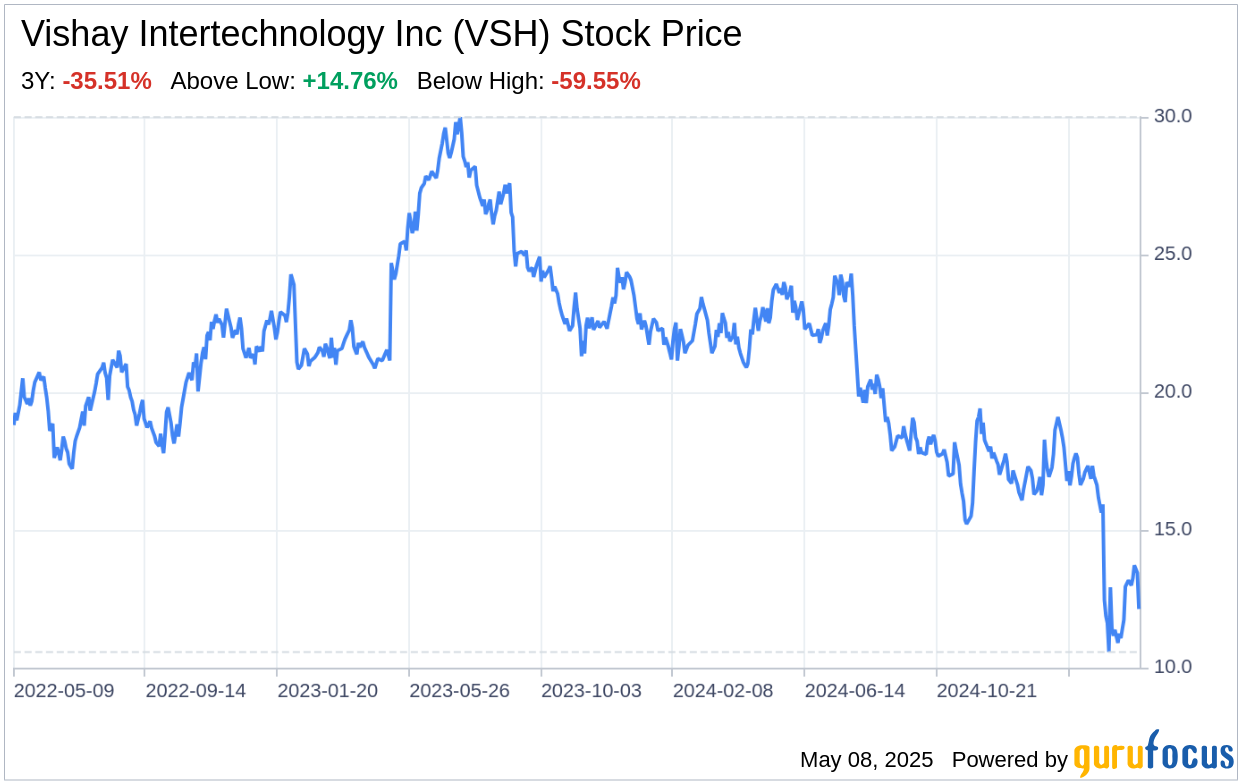Vishay Intertechnology Inc (VSH, Financial), a leading manufacturer of discrete semiconductors and passive electronic components, recently filed its 10-Q on May 7, 2025. This SWOT analysis delves into the company's financial health and strategic positioning based on the latest filing. Vishay serves a diverse range of markets, including industrial, computing, automotive, consumer, telecommunications, military, aerospace, and medical. The company's financial performance for the quarter ending March 29, 2025, shows net revenues of $715,236, a decrease from the previous year's $746,279. Despite a reduction in gross profit from $170,407 to $135,554, Vishay maintains a solid market presence with its broad product portfolio and global customer base.

Strengths
Robust Product Portfolio and Market Presence: Vishay's diverse range of products, including MOSFETs, diodes, optoelectronic components, resistors, inductors, and capacitors, positions the company as a one-stop-shop for electronic components. This extensive portfolio allows Vishay to cater to various customer needs and withstand market fluctuations in specific product categories. For instance, the company's net revenues from resistors, a fundamental component in electronic circuitry, remain a significant revenue stream, showcasing the company's strong foothold in essential electronic components.
Global Operations and Customer Base: With operations spanning multiple continents, Vishay benefits from a global customer base, reducing dependence on any single market. The company's international presence not only diversifies revenue streams but also provides strategic advantages in sourcing materials and manufacturing components. This global reach is evident in the company's revenue distribution across different regions and end markets, indicating resilience against regional economic downturns.
Financial Management and Capital Allocation: Vishay's financial discipline is reflected in its ability to manage costs effectively, as seen in the relatively stable costs of products sold despite fluctuations in net revenues. The company's commitment to returning value to shareholders through dividends, as indicated by the consistent cash dividends per share, underscores its financial stability and prudent capital allocation strategies.
Weaknesses
Declining Net Revenues and Profitability: The recent 10-Q filing reveals a concerning trend of declining net revenues and profitability. The decrease in net earnings from $31,443 to a loss of $4,092, alongside a drop in gross profit margin from 22.8% to 19.0%, signals potential challenges in maintaining profitability. This decline may be attributed to competitive pressures, pricing dynamics, or operational inefficiencies that need to be addressed to reverse the downward trajectory.
Operational Inefficiencies: The increase in selling, general, and administrative expenses from $127,736 to $134,739 suggests potential operational inefficiencies. As these costs outpace revenue growth, Vishay may need to evaluate its operational processes and cost structures to improve margins and operating income, which has fallen from $42,671 to a mere $815.
Market Sensitivity and Cyclical Demand: Vishay's performance is closely tied to the cyclical nature of the semiconductor and electronic components industry. The company's reliance on end markets such as automotive, industrial, and consumer electronics exposes it to market volatility and economic cycles, which can lead to fluctuations in demand and pricing pressures.
Opportunities
Emerging Market Trends and Technological Advancements: Vishay is well-positioned to capitalize on emerging trends such as electrification, renewable energy, and the Internet of Things (IoT). By leveraging its broad product portfolio and R&D capabilities, the company can develop innovative components that cater to these growing markets, potentially driving future revenue growth.
Strategic Acquisitions and Partnerships: The company's strong balance sheet and cash flow generation provide opportunities for strategic acquisitions and partnerships. These initiatives can expand Vishay's product offerings, enter new markets, and acquire cutting-edge technologies, further solidifying its market position.
Global Supply Chain Optimization: Vishay has the opportunity to optimize its global supply chain, reducing costs and improving efficiency. By leveraging its international footprint, the company can streamline operations, negotiate better terms with suppliers, and enhance its responsiveness to market changes.
Threats
Intense Competition and Price Erosion: The electronic components industry is highly competitive, with constant pressure on pricing and margins. Vishay faces competition from both established players and emerging entrants, which can lead to price erosion and impact profitability.
Geopolitical Risks and Trade Uncertainties: As a global company, Vishay is exposed to geopolitical risks and trade uncertainties, including tariffs and trade disputes. These factors can disrupt supply chains, increase costs, and create market volatility, potentially affecting the company's financial performance.
Technological Disruption and Product Obsolescence: Rapid technological advancements can render existing products obsolete, requiring continuous innovation and investment in new technologies. Vishay must stay ahead of technological trends to maintain its competitive edge and avoid the risk of product obsolescence.
In conclusion, Vishay Intertechnology Inc (VSH, Financial) exhibits a strong market presence and robust product portfolio, which are key strengths in navigating the competitive landscape of the electronic components industry. However, the company faces challenges in reversing the trend of declining revenues and profitability. Opportunities for growth lie in emerging market trends and strategic
This article, generated by GuruFocus, is designed to provide general insights and is not tailored financial advice. Our commentary is rooted in historical data and analyst projections, utilizing an impartial methodology, and is not intended to serve as specific investment guidance. It does not formulate a recommendation to purchase or divest any stock and does not consider individual investment objectives or financial circumstances. Our objective is to deliver long-term, fundamental data-driven analysis. Be aware that our analysis might not incorporate the most recent, price-sensitive company announcements or qualitative information. GuruFocus holds no position in the stocks mentioned herein.
